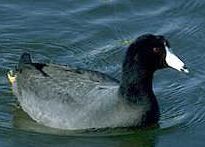With fleshy lobes on its toes and a predilection for diving, the American Coot is the most aquatic of all the Texas rails (Oberholser 1974). In its aquatic habits the coot suggests a duck so strongly that studies and censuses of waterfowl have often included the coot (Alisauskas and Arnold 1994.)
The American Coot breeds across much of southern Canada and the United States, and south to northern Costa Rica (Taylor 1998). Breeding Bird Survey (BBS) information indicates coots breed most commonly in British Columbia, Alberta, Saskatchewan, the Dakotas, Oregon, California, Nevada and Utah. Coots were also recorded by the BBS at low to medium density in the Rocky Mountain and Great Plains states including Texas (Sauer et al. 2005). BBS data may be inadequate, however, in areas where coots are patchily distributed in a few large breeding marshes (Alisauskas and Arnold 1994).
DISTRIBUTION: During the 1987-1992 field work seasons of the TBBA project, volunteers found confirmed breeding by the American Coot in every atlasing region except upper east Texas, where there were nevertheless a few possible and probable breeding records. Based on TBBA reports, nesting is concentrated in four regions: the Panhandle, the south plains, Trans-Pecos, and south Texas; over 80% of confirmed breeding reports were from these areas. None of the other regions had more than 5 reports of confirmed breeding. Over 300,000 coots winter in Texas, about 60% of them in the coastal region (US Fish & Wildlife Service data). Only Louisiana, California, and Florida host more wintering individuals than Texas (Alisauskas and Arnold 1994).
SEASONAL OCCURRENCE: TBBA data recorded nests with eggs from June 13 to July. 15. Nesting obviously occurs at much earlier and later dates than this, however, since downy chicks were recorded as early as April 30 at a golf course in Big Spring (latilong 32101) and as late as August 30 near Monahans (31102). Oberholser (1974) states coots in Texas nest from early April through mid September. It is noteworthy, however, that winter nesting has occurred in Florida (Taylor 1998). Since south Texas lies at a similar latitude, it is conceivable that winter nesting could likewise occur among coots in Texas.
BREEDING HABITAT: Based mainly on studies conducted in north-central North America, Allen (1985) determined semi- permanently flooded wetlands with nearly a 1:1 ratio of emergent vegetation to open water and a high degree of interspersed edge between water and cover provide optimum breeding habitat for American Coots.
As long as sufficient food and nesting cover are available, however, a variety of aquatic environments may be used for nesting (Oberholser 1974). In Texas, the TBBA recorded coot nests or adults with chicks in natural habitats such as marshes and playa lakes, but also in man-made environments such as wastewater treatment ponds, reservoirs and irrigation ponds, generating station cooling ponds, borrow ditches, and golf course water hazards.
Esler (1990) found increased use of a Texas reservoir by wintering coots was positively correlated with an increase in the abundance of hydrilla (Hydrilla verticillata), an exotic submergent plant which provided food for the birds. It has not been recorded, however, whether the spread of hydrilla has rendered Texas waterways more inviting to nesting coots as well as wintering ones.
Coot nests are cups woven from dried leaves and stems of marsh plants; often they are floating and anchored to surrounding emergent vegetation. Nests may or may not be well concealed (Alisauskas and Arnold 1994). A Texas study found water depth at the nest site was generally 15-76 cm (6-30 in) and nests were usually built so eggs lay 5-30 cm (2-12 in) above water (Cottam and Glazener 1959). Special platforms for brooding chicks may also be constructed (Alisauskas and Arnold 1994).
STATUS: The TBBA map is similar to the map presented by Oberholser (1974). TBBA data do show, however, a greater incidence of breeding in the Trans-Pecos than Oberholser indicated.
The coot is widely hunted in many parts of North America, including Texas. Annual retrieved kill in Texas during the period from 1952 to 1991 averaged 25,000 birds per year (Alisauskas and Arnold 1994).
Habitat loss has been blamed for a decline in coot numbers in eastern North America (Alisauskas and Arnold 1994). The status of the American Coot is hard to determine. Popula- tions vary from year to year, based on varying moisture levels and land management across its wide breeding range, making long term trends difficult to quantify (Brisbin and Mowbrray 2002, Sauer et al. 2005). The species is currently considered to be uncommon to common in summer in Texas (Lockwood and Freeman 2004).
Text by Brett K. Bannor (ca. 1999, posted with updates 2006)
Literature cited.
Alisauskas, R. T. and T. W. Arnold. 1994. American Coot. Pp. 127-143 in Migratory shore and upland game bird management in North America (T. C. Tacha and C. E. Braun eds.). Int. Assoc. Fish Wildl. Agencies, Allen Press, Lawrence, KS.
Allen, A. W. 1985. Habitat suitability models: American Coot. U.S. Fish and Wildl. Serv. Biol. Rep. 82 (10.115).
Brisbin, I. L., Jr. and T. B. Mowbray. 2002. American Coot (Fulica americana). InThe Birds of North America, No. 69731 (A. Poole and F. Gill, eds.). The Birds of North America, Inc., Philadelphia, PA.
Cottam, C. and W. C. Glazener. 1959. Late nesting of waterbirds in south Texas. Trans. N. Am. Wildl. Conf. 24: 382-395′
Esler, D. 1990. Avian community responses to hydrilla invasion. Wilson Bull. 102: 427-440.
Lockwood, M. W. and B. Freeman. 2004. The TOS handbook of Texas birds. Texas A&M University Press, College Station.
Oberholser, H. C. 1974. The bird life of Texas, University of Texas Press, Austin.
Sauer, J. R., J. E. Hines, and J. Fallon. 2005. The North American Breeding Bird Survey, results and analysis 1966-2005. Version 6.2 2006. USGS Patuxent Wildlife Research Center, Laurel MD < http://www.mbr-pwrc.usgs.gov/bbs>
Taylor, B. 1998. Rails: A guide to the rails, crakes and coots of the world. Yale University Press, New Haven, CT.

